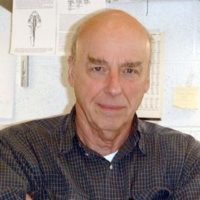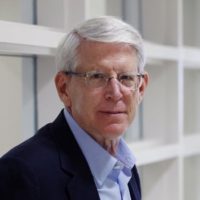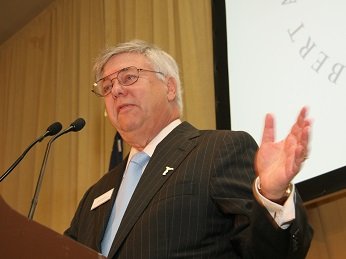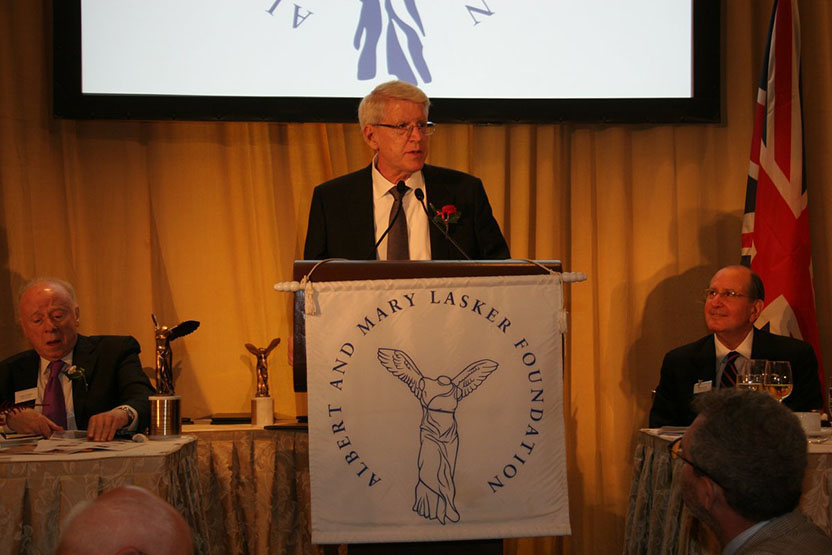
Donald D. Brown
Carnegie Institution for Science in Baltimore

Tom Maniatis
Columbia University
The 2012 Lasker~Koshland Award for Special Achievement in Medical Science honors two individuals for their exceptional leadership and citizenship in biomedical science. Donald D. Brown (Carnegie Institution for Science in Baltimore) and Tom Maniatis (Columbia University) have made numerous fundamental discoveries concerning the nature of genes and have contributed in substantial ways to the scientific community. Brown has demonstrated selfless commitment to young scientists by founding and leading the Life Sciences Research Foundation, an inventive partnership that provides postdoctoral fellowships to some of the world’s most promising researchers, and he mentored a generation of scientists at the Embryology Department at the Carnegie Institution. Maniatis created the quintessential Molecular Cloning manual — based on his own pioneering work — and thus spread revolutionary technologies into a multitude of laboratories across the world.
Brown’s interest in genes sprouted in medical school, when he began wondering how embryos develop. At the time — in the mid-1950s — scientists had mapped out that process’s anatomical features, but its molecular underpinnings remained opaque. When Brown launched his independent research program, he boldly decided to delve into the details. By studying embryos that die at a particular early developmental stage — when new ribosomes, cellular protein factories, start accumulating — Brown, in collaboration with John Gurdon (Lasker Basic Medical Research Award, 2009), discerned that a structure called the nucleolus performs a crucial job for the cell: It manufactures structural RNAs of the ribosome (ribosomal RNAs, or rRNAs).
Award presentation by Michael Brown
 The Lasker~Koshland Special Achievement Award is “special” because great science is only the ante. The winner must have done something special to advance science itself, hopefully by helping young scientists.
The Lasker~Koshland Special Achievement Award is “special” because great science is only the ante. The winner must have done something special to advance science itself, hopefully by helping young scientists.
This year, the Lasker Jury was deadlocked. Two candidates soared high above the rest. Both deserved the award. Even Joe Goldstein couldn’t break the deadlock. So we will break tradition instead. Today we present two Special Achievement Awards — to Don Brown and Tom Maniatis.
Acceptance remarks

Acceptance remarks, 2012 Lasker Awards Ceremony
What a thrill it was to receive a phone call one morning in June from Joe Goldstein and how deeply grateful and honored I am to receive this award.
Two important themes have influenced my 50 years in science. The first is independence. For me, the fun of doing science has been to be my own boss, and any pleasure that I have had as an administrator of science has been running interference for colleagues following their own visions. I have been fortunate to work at the Carnegie Institution for Science for my entire career, where independence is encouraged and supported.
My second theme is the importance of young scientists in research. The simple lesson that research is best done by young people guided me as director of our department to set up independent positions for new PhDs. It has been rewarding to watch them develop their careers. My interest in young scientists is partly responsible for founding the Life Sciences Research Foundation, an international postdoctoral fellowship agency whose goal has been to support the very best young scientists at their most productive time. The history of LSRF goes back to 1980, when molecular biology inspired by the new recombinant DNA technology was poised to revolutionize the pharmaceutical industry. These discoveries were made at nonprofit institutions paid for by the government mainly through the extramural grant programs of NIH. The companies that would commercialize these new methods did not discover them. Is there a better example of the role of government generating an entirely new industry? I expected that companies would have a new interest in the biological research carried out in universities and research institutions. After some thought and consultation, we started a simple postdoctoral fellowship agency that I hoped would be sponsored by the very pharmaceutical companies poised to benefit from these discoveries. Over the last 30 years, LSRF has supported 456 fellows. We have never had endowment, so we solicit sponsors every year. These sponsors include research-oriented companies, the Howard Hughes Medical Institute, a variety of foundations, one government agency, and several philanthropic scientists. One of the rewards for running the Life Sciences Research Foundation has been calling the winners to deliver the news. Their ecstatic reaction to my phone call says a lot about our line of work. Consider what they are so thrilled to receive: The princely salary is $42,000 for a beginning fellow with a PhD, who is usually over 30 years old and probably has a family. These fellows have competed successfully for the privilege of working night and day. The enthusiastic response of these budding superstars makes me proud to be part of the scientific profession.

Acceptance remarks, 2012 Lasker Awards Ceremony
My scientific career has spanned a transformative period in biomedical research. I was ten years old when Watson and Crick published the structure of DNA, and by the time I was in high school, the basic outlines of how DNA is replicated and transcribed were known, and the genetic code had been cracked. However, as a teenager growing up in Denver, Colorado, molecular biology was a far-away world for which I had no knowledge.
My father was a Denver fireman, the son of a Greek immigrant, and my mother a housewife and daughter of a Missouri farmer of Irish ancestry. My father wanted me to follow in his footsteps, but my mother had higher expectations. She was therefore delighted when my high school chemistry teacher detected a faint intellectual spark in me and encouraged application for a tuition scholarship at the University of Colorado at Boulder. I was surprised when I received an acceptance letter and a scholarship of $300 per semester: in-state tuition at the time.
When I arrived in Boulder I decided to major in chemistry, but also became interested in biology. Initially the only biology courses available were in the Zoology Department, and I was required to take courses that required massive amounts of rote memorization. I was stuck, as I was bored by zoology and had decided I did not want a career in chemistry. However, two events occurred that changed the direction of my life. First, while browsing through the bookstore I came upon Jim Watson’s Molecular Biology of the Gene, an elegantly written and illustrated book that captured a spectacularly exciting mix of genetics, biochemistry, and structure. This book introduced me to a new and exciting field of biology. Second, in my junior year, the university established a new initiative in molecular and cellular biology, hired new faculty and offered courses in biochemistry and modern cell biology for the first time. I was suddenly transformed from a disinterested observer into a student driven to learn.
Since then, my passion for molecular biology has never waned. I have had brilliant and inspiring mentors, incredible colleagues, and extraordinary students and postdoctoral fellows. I have participated in and marveled at the progress that has provided deep insights into the complexity of biology and has directly impacted our understanding and treatment of human diseases. As an undergraduate in zoology, I could not have imagined that in my lifetime there would be such a direct connection between basic research and the clinic.
I am therefore deeply honored to be standing here today to receive this honor from a foundation established by Mary Lasker, whom more than anyone advocated for medical research funding, and played a key role in the rise of the National Institutes of Health. NIH funded my postdoctoral fellowship at Harvard and subsequently my laboratory for over 35 years.
I had the privilege of meeting Mary Lasker in 1980 during her visit to Caltech, where she was searching for a possible role of interferon in cancer. At the age of 80, her passion for finding a cure for cancer was still palpable. So today is not only a celebration of the accomplishments of the Lasker Award recipients, it is also a celebration of Mary Lasker’s passion and contributions, and of the entire biomedical research community. I am deeply honored by this recognition, and especially proud to be named as a co-recipient with Don Brown.
Interview with Donald D. Brown and Tom Maniatis
Video Credit: Susan Hadary

